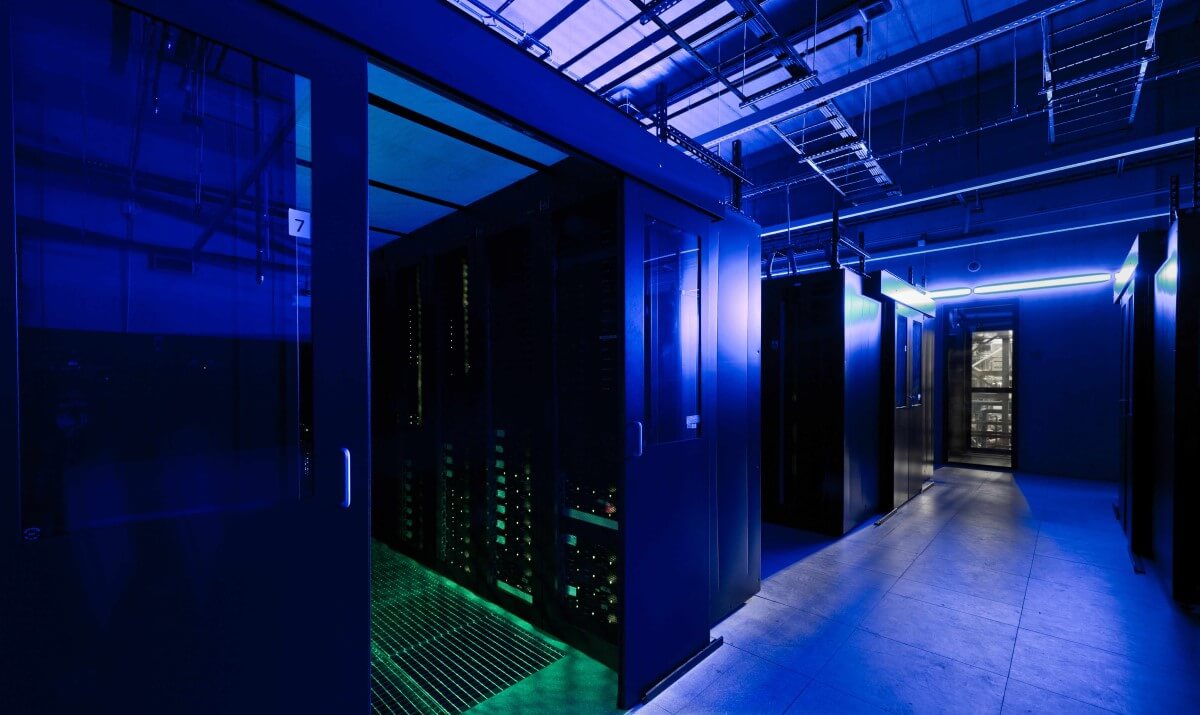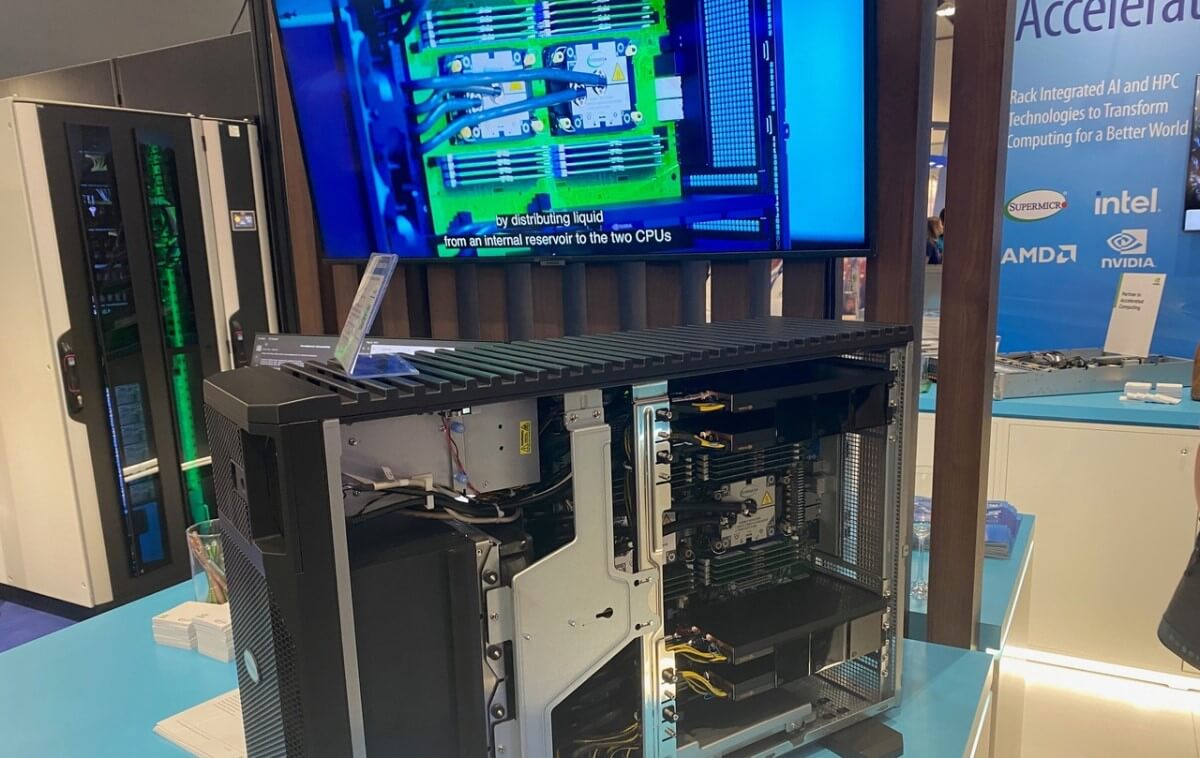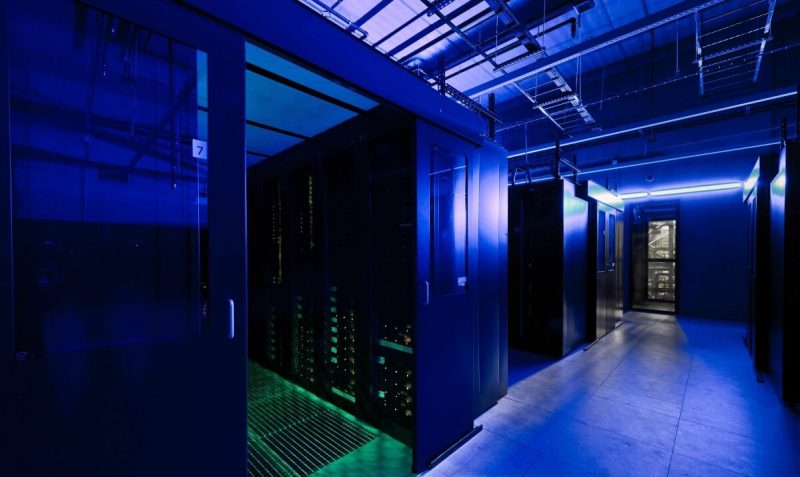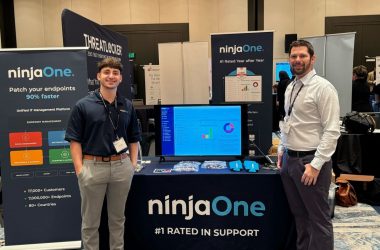

Data Center Market Trend 1 – AI Disrupts Construction
Artificial intelligence (AI) has the potential to drastically change the digital infrastructure market when it is incorporated into data center operations, stated Soben in its report. Experts agree that while projections differ, artificial intelligence (AI) will significantly increase the need for data center capacity, bringing about a sea change in the industry’s dynamics.
According to a notable study conducted by investment company TD Cowen, the growing demands of artificial intelligence (AI) have led to an incredible spike in data center leases in the US, with a record of 2,100 megawatts inked in only 90 days at the end of 2022. This trend is not only a passing fad; estimates from Schroders suggest that over the next three years, demand for these services will rise by an astounding seven times, highlighting the significant influence artificial intelligence will have on the need for digital infrastructure.
The specific requirements of artificial intelligence and high-performance computing are causing a significant change in the architectural and operational paradigms of data centers. These next-generation data centers, in contrast to traditional ones, need sophisticated processing equipment that can manage power loads that are much larger—possibly up to eight times higher than those of normal arrangements. In addition to increasing heat generation, this rise in power consumption makes liquid cooling technologies necessary in order to efficiently handle the increased thermal output.
Facebook’s parent firm, Meta Platforms, has garnered news throughout this revolutionary period for its strategy shift toward the development of hybrid data centers. With the first project under progress in Texas, these cutting-edge facilities can handle both conventional computing and the more demanding AI processing duties. This action is a reflection of a larger industry trend toward adaptable infrastructure that can meet the future’s varied computing requirements.
But there’s still a lot of unknown in the development of AI-driven data centers. The business is at a crossroads, and many are waiting for the big IT companies to take the lead, as noted by Pieter Schaap, Director at Soben. This reluctance is due to the difficulties in designing and building infrastructure that can support AI’s two stages, training and inception, each of which has different needs in terms of size, effectiveness, and location.
The difficulty is exacerbated by the fluidity of building schedules, whereby some projects are shelved and others see swift revisions – like fiber optic improvements for faster data transfer rates. As an example of the agility needed in this new age, AQ Compute in Norway changed its cooling system mid-construction to meet the unique requirements of a major tenant.
One thing is certain as the industry struggles with these issues: the emergence of AI is not only changing the technology environment but also requiring a new design for the infrastructure that supports the digital world. According to Soben’s expert, the future will need creative thinking, smart planning, and a willingness to accept the revolutionary changes brought about by AI’s incorporation into our digital lives, as demand for data centers is predicted to grow.
Data Center Market Trend 2 – Leaps in liquid Cooling
Immersion cooling technology, which involves immersing computers in a dielectric fluid, is developing as a new approach to regulating the heat created by data centers. This development would illustrate the tech industry’s shift towards more sustainable and efficient cooling solutions. Although not yet widely used, this method – notable for its higher energy efficiency – is gaining favor among progressive businesses, stated Soben in its report.
Leading infrastructure supplier GlobalConnect said in February 2023 that, subject to client request, it is considering implementing immersion cooling across its network of 16 data centers located in Denmark, Norway, Sweden, Germany, and Finland. Comparably, the UK’s largest telecom company, BT, said in September that it was testing a number of liquid cooling options, including submerging networking equipment entirely. These programs highlight the IT sector’s pressing need for cutting-edge cooling technology, particularly in AI data centers where effective heat management solutions are becoming more and more important.
A major topic of conversation about the architecture of AI data centers in the future is the development of cooling solutions. The industry is faced with a conundrum as developments are expected to increase throughout the year: the need to embrace new cooling solutions quickly, but at the risk of investing too soon in quickly developing technology. Some developers are allocating more funds up front to future-proof their buildings by adding more piping, which enables the adoption of other cooling techniques as they become available, in an effort to lessen these difficulties.
Data centers are being forced to investigate various techniques due to the need for liquid cooling, especially for the heat-intensive graphics processing units (GPUs) that are essential for AI calculations. Right now, direct-to-chip cooling systems and rear-door heat exchangers are two of the most often used options. But because of their potential to drastically cut energy costs and enhance thermal management, immersion cooling and other cutting-edge techniques are drawing interest from the industry.
There are several obstacles to overcome when updating current data centers to include these cutting-edge cooling technologies. These include the high expenses and the logistical arrangements involved in setting up the required infrastructure. Some facilities are moving forward with these renovations in spite of these obstacles. Verne Global, for instance, said in December 2023 that liquid cooling methods will be used in some areas of their subterranean data center in Finland, called ‘The Rock.’
Proactively building data centers with the ability to integrate different cooling solutions is being done by developers such as Kevlinx, stated Soben. Commencing construction in September, the company’s first data center in Brussels is outfitted to accommodate various cooling techniques, such as indirect evaporative cooling, and may accommodate chilled or condenser-based systems as needed.
In addition to meeting the immediate thermal management requirements of AI data centers, this strategic focus on flexible and energy-efficient cooling technologies also supports the industry’s larger objective of attaining sustainability and operational efficiency in the face of rising computational demands.
– story continues below the photo –
![]()
![]()
Data Center Market Trend 3 – Higher Power Plays
The growing power crisis is a major obstacle that the global data center business must overcome and one that might determine its future course. The demand for electricity is significantly higher than the supply in any sector in the world. This has led to a reassessment of the management of data centers, power production, and energy transmission, stated Soben in its 2024 trends report.
Power outages are a well-known issue in Northern Virginia, a crucial data center location in the United States. On the other hand, comparable problems are emerging all across the continent. Insufficient power supply has caused delays in projects in Chicago, for instance. Denver-based director of Soben, Mark Smith, highlights the need of long-term planning and says that a systematic strategy that looks 10 to 15 years ahead is essential to reducing these difficulties.
In Latin America, where almost all of the major data center locations are struggling with power constraints, the situation is just as bad. Cities like Sao Paulo in Brazil, Santiago in Chile, Bogota in Colombia, and Queretaro, Monterrey, and Tijuana in Mexico are all having trouble obtaining adequate electricity. Notably, in contrast to other nations in the area, Brazil and Chile do not exclusively depend on electricity supplied by the state.
Similar limitations are also present in Europe’s FLAP D markets (Frankfurt, London, Amsterdam, Paris, and Dublin); in fact, grid capacity problems are also present in secondary markets like Berlin. According to Peter Alexander, another director of Soben, there is strong demand in the present market since Berlin’s projected data center developments are actively investing in substation renovations and electricity. Robert McQueen, director of operations at Soben, notes that the continent’s electricity distribution network is in severe need of modernization and advocates for large government investment to improve the grid’s capacity and dependability.
Some data center owners have chosen to purchase more generators during the building process in response to the growing need for power, which is partially driven by the adoption of AI technology and the possibility of outages. Furthermore, secondary markets with more dependable power access – like those in Europe, such as Madrid, Rome, Barcelona, Zurich, Warsaw, and Vienna – and North America, such as Reno, Nevada, and Charlotte, North Carolina – are seeing a surge in demand as a result of the power crisis. There’s been a lot more going on in Canada as well; Stack and Microsoft have announced big investments in Toronto and Quebec, respectively.
Governments are starting to act on the industry’s pleas for action, which is encouraging. Cesar Virgen has hailed the establishment of the Mexican Association of Data Centers (MEXDC), which has enabled communication with government agencies and resulted in promises to solve power-related difficulties. The governments of Singapore and Ireland have also changed their positions, allowing new investments and projects to go forward while taking the environment into account.
This changing environment would point to a crucial turning point for the data center sector. The sector’s capacity for innovation and adaptation will be essential to its resilience and continuing expansion as it negotiates the challenges of environmental sustainability, governmental involvement, and power supply.
Data Center Market Trend 4 – New Power Horizons
Due to power shortages and mounting environmental, social, and governance (ESG) concerns, the data center industry is at a crossroads and is facing previously unheard-of difficulties. Due to these difficulties, there is a discernible increase in power purchase agreements (PPAs) and growing interest in nuclear power as a long-term option, which is driving a major shift towards renewable energy sources, according to Soben’s trends report.
Big IT corporations are driving the adoption of renewable energy throughout Europe. In 2023, Google and Eneco confirmed a ten-year agreement to harvest wind energy in the Netherlands, while Equinix signed a ten-year solar energy contract with Sonnedix in Portugal. In a similar vein, Engie of Germany promised to provide Digital Realty with solar energy from a Brandenburg solar park. The transition to renewable energy is not limited to Europe. In Africa, Africa Data Centres signed a 20-year PPA with DPA Southern Africa, while Orange Côte d’Ivoire teamed with SolarX Group to power data centers in Yamoussoukro and Ouagadougou with solar energy.
The switch to renewable energy is not without its challenges, however. Experts warn that the process for determining greenhouse gas emissions may change over time, which might change how sustainable renewable energy projects are rated according to how clean their particular networks are. The price and financial risk-sharing arrangements between energy suppliers and data center operators may be affected by this recalibration, which might be particularly difficult for smaller firms that might not have the means to deal with the changes.
The investigation of nuclear energy, particularly via the creation of small modular reactor (SMR) nuclear reactors, gives the story a fascinating twist. Early in 2023, the U.S. Nuclear Regulatory Commission certified a NuScale design, which was a significant development, however hopes were dampened when a commercial project in Utah was later canceled. In spite of this setback, businesses such as Oklo, BWX Technologies, Kairos electricity, and X-energy are developing cutting-edge methods to provide data centers with SMR-generated electricity via PPAs. A increasing number of people worldwide are becoming interested in nuclear power as a sustainable energy source for data centers. This is shown by the UK government’s excitement for SMRs, as seen by its partnership with Rolls Royce and Last Energy.
Beyond nuclear and conventional energy, the industry is also looking at the possibility of using hydrogen fuel cells as a renewable energy source. Partnerships like the one between SK Group and Lumcloon Energy in Ireland and Equinix and the National University of Singapore underscore the early phases of this research and the long-term perspective needed to handle the infrastructure issues related to hydrogen electricity.
The data center sector is facing a more varied future as it manages the intricate relationship between electricity supply, environmental responsibility, and technological innovation. The embracement of renewable energy, the cautious optimism about nuclear power, and the experimental ventures into hydrogen fuel cells signify a comprehensive strategy to guarantee a robust and sustainable energy future for the driving force behind the digital era.
Data Center Market Trend 5 – Fighting for Talent
The data center sector is now dealing with a significant issue that may prevent it from growing further: a marked shortage of qualified workers and specialized businesses. A wide range of professions are affected by this shortage, including general contractors, artisans, electrical and mechanical contractors, and construction management specialists. Talent acquisition is becoming more competitive, creating a dynamic employment market where professionals are drawn to offers that are becoming bigger and better.
Peter Alexander, Director Data Centers Europe at Soben, emphasizes the industry’s competitiveness, pointing out that poaching activity has significantly increased and that this has resulted in an increase in management expenses. Due to the increasing demand for their services, subcontractors are forced to pay more for competent workers, which is indicative of the industry-wide trend of rising prices.
Some businesses are grouping projects together to form bigger, more desirable contracts in order to overcome these obstacles. In order to draw contractors, Mark Smith used the example of an owner who combined two projects into a big $100 million transaction to demonstrate this tactic. Smith stresses the need to preserve quality by making sure contractors can deploy their finest teams without being overworked, but he also warns against the danger of overstretching.
Cesar Virgen, who is engaged in data center projects in the US and Mexico, claims that the physical location of many data centers – which are often located in distant areas – complicates the recruiting difficulty. Attractive incentives beyond base pay are necessary to persuade experts to migrate for job.
As a result, astute data center owners are spending money on improved work spaces to draw more people to these distant locations. Enhancing on-site facilities like canteens and providing competitive pay, incentives, and per diems are some of the ways they hope to draw in and keep the vital labor force required to keep the sector expanding.
The manpower shortage is expected to remain a critical concern as the data center industry grows. By implementing tactical modifications and emphasizing the development of engaging workplaces, the sector aims to surmount these obstacles and sustain its rapid growth trajectory.
Data Center Market Trend 6 – Portfolio-Style Planning for Long Lead Times
The issue of prolonged lead times for essential materials and equipment remains a challenge for professionals in the data center construction industry on both sides of the Atlantic, according to Soben’s 2024 trend report. Although the severity of this problem has not increased as it did during the peak of the Covid pandemic, it still has a significant impact on project timelines and costs. Using a systematic approach to multi-center development initiatives has become essential as developers navigate these choppy seas.
Martin Brown, Lead Project Manager at Soben, observes from Atlanta that a number of critical components, such as mechanical and electrical equipment, IT infrastructure, and important structural components like roofing, structural steel, and precast concrete, consistently have lengthy lead times. Beyond just creating logistical challenges, these delays have in some cases brought projects to a full halt and resulted in financial difficulties amounting to tens of millions of dollars because of idle contractors.
Soben director Mark Smith agrees, pointing out the significant financial consequences of equipment delays in the United States, where contractors are often kept waiting – and paid – for work that cannot go forward. These difficulties are reflected in the situation in Europe, where lead times for large equipment, such as transformers and generators, may reach minimum 20 months. Providing insight from a European standpoint, Soben director Peter Alexander points out that as essential components are universally sourced from a few number of vendors, these concerns must be addressed as early as the land acquisition stage.
The use of Owner Furnished Contractor Installed (OFCI) products has grown in popularity as a way to reduce these delays. This technique, which involves project owners directly purchasing essential equipment and supplies, was first embraced by significant industry players and has since gained traction. The approach outlines a pipeline of projects and orders that spans many years, giving data center owners the ability to reserve production slots and prioritize delivery. But as Soben’s assistant director, May ZorTemmink, notes, this approach cannot address the underlying problem of low supply on its own without a substantial and quick expansion in production capacity.
As a result, data center businesses are taking preemptive measures to secure funding and place large orders for equipment. Some even choose to keep products on-site in many locations or use a portfolio strategy to manage their projects more flexibly. To keep other projects on schedule, equipment from postponed projects may need to be reallocated. Larger subcontractors, according to Martin Brown, are placing preorders for equipment in advance of contract wins. This strategy may drastically cut lead times and influence project choices.
Despite these practical challenges, creative solutions are starting to appear, stated Soben in its report. Artificial intelligence is now being used by certain businesses to improve building timetables, providing a window into the direction that project management in the data center sector may go. AI technologies are assisting in streamlining building timeframes by evaluating schedules and suggesting substitute approaches, demonstrating the industry’s flexibility and perseverance in the face of persistent difficulties.
– story continues below the photo –


Data Center Market Trend 7 – Automotive Build Style Brings speed and Quality
Another trend observed by Soben in its 2024 trend report is the fact that the data center industry is embracing a revolutionary change towards digital building approaches in an era when speed to market is of the essence. This transition is being driven by extended lead times for equipment, scarcity of materials, and a paucity of experienced personnel. This evolution is a realization of what industry visionaries have been advocating for decades: a paradigm shift towards a ‘design for manufacture and assembly’ (DfMA) approach, which takes inspiration from automotive engineering rather than traditional construction practices. It is not just a reaction to modern challenges.
Prominent industry advocate Martin Brown points out that prefabrication, which was once seen as an unusual idea, is now a common tactic. “Contractors can enhance their profit margins by utilizing less expensive labor and assembling materials offsite in controlled environments,” he says. This change would substantially increase production while simultaneously allaying safety worries.
Pieter Schaap draws attention to an additional benefit of offsite construction: improved quality control. Higher standards are ensured by manufacturing components in a controlled environment, which is an advantageous strategy in distant or developing regions like Africa where trained labor may be hard to come by. Mr. Schaap also notes that the prices of offsite building are starting to come down in response to the growing demand for these methods, which makes them a more attractive alternative to conventional construction methods.
Some colocation providers have noted that the market is moving toward modular construction, which enables scalable development in tandem with tenant acquisition, assuring optimum space usage and perhaps reaching 100% occupancy rates. “Modularization isn’t limited to the foundational aspects like transformers and switch gears; even the ‘white space’ – the operational areas of data centers – is being containerized,” added Mr. Schaap.
Building Information Modeling, or BIM, is essential to this strong digital design infrastructure that is required because to the increasing dependence on prefabrication and modular components. “With projects being fully coordinated virtually before any physical construction begins, participation in the BIM process becomes mandatory for subcontractors,” says Brown. By allowing for the proactive settlement of any problems, this digital coordination speeds up the building process.
Furthermore, data center designs may be replicated across multiple sites with only site-specific modifications and regional variances because to the use of BIM and offsite building techniques. This could be a major step forward for the data center sector in meeting the rapidly increasing need for digital infrastructure, since it not only improves efficiency but also standardizes quality, stated Soben.
Download Full Soben Report
The full ‘Soben Data Centre Trends Report 2024’ with all ten trend predictions for the data center market in 2024 can be found here.









